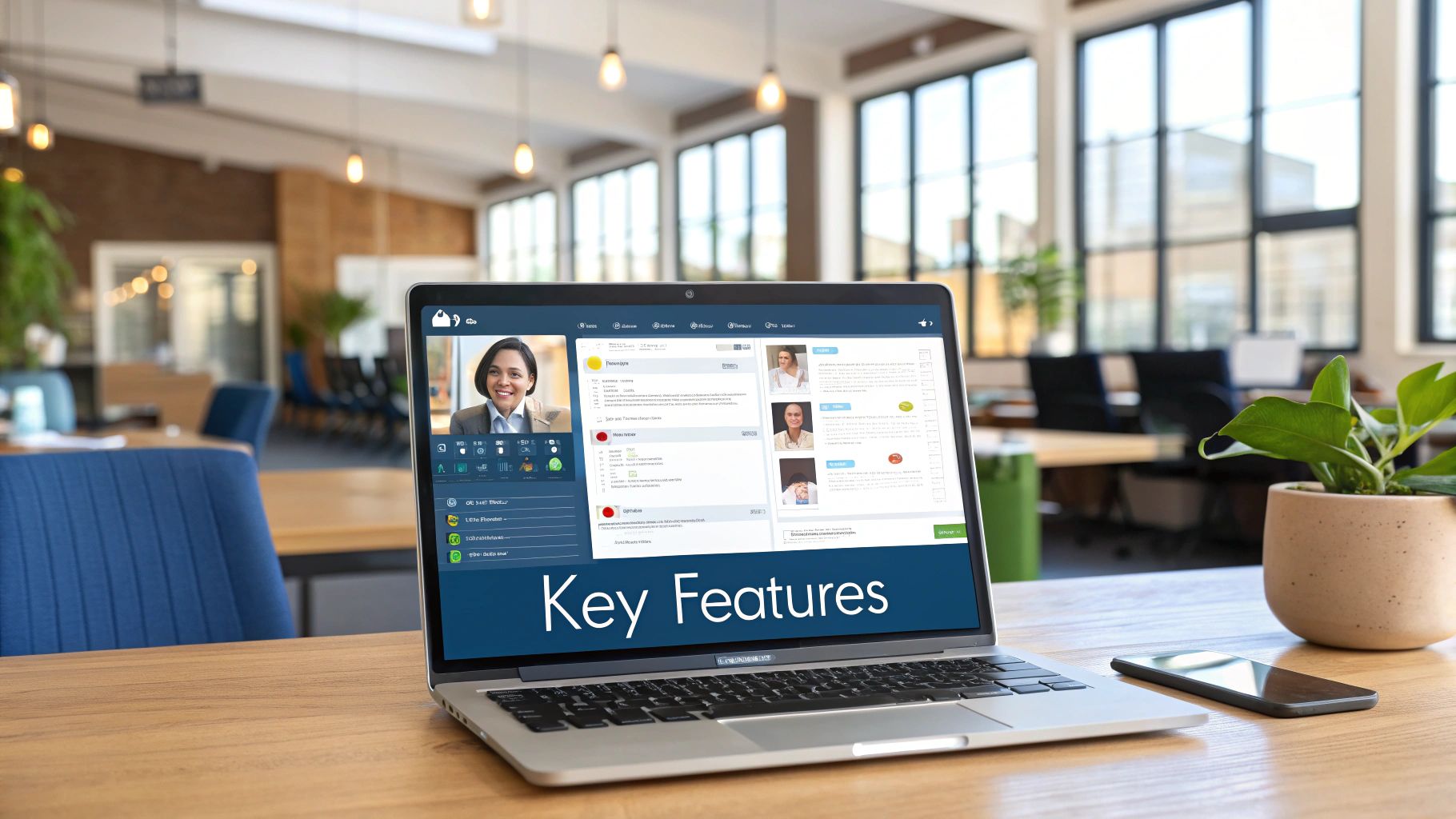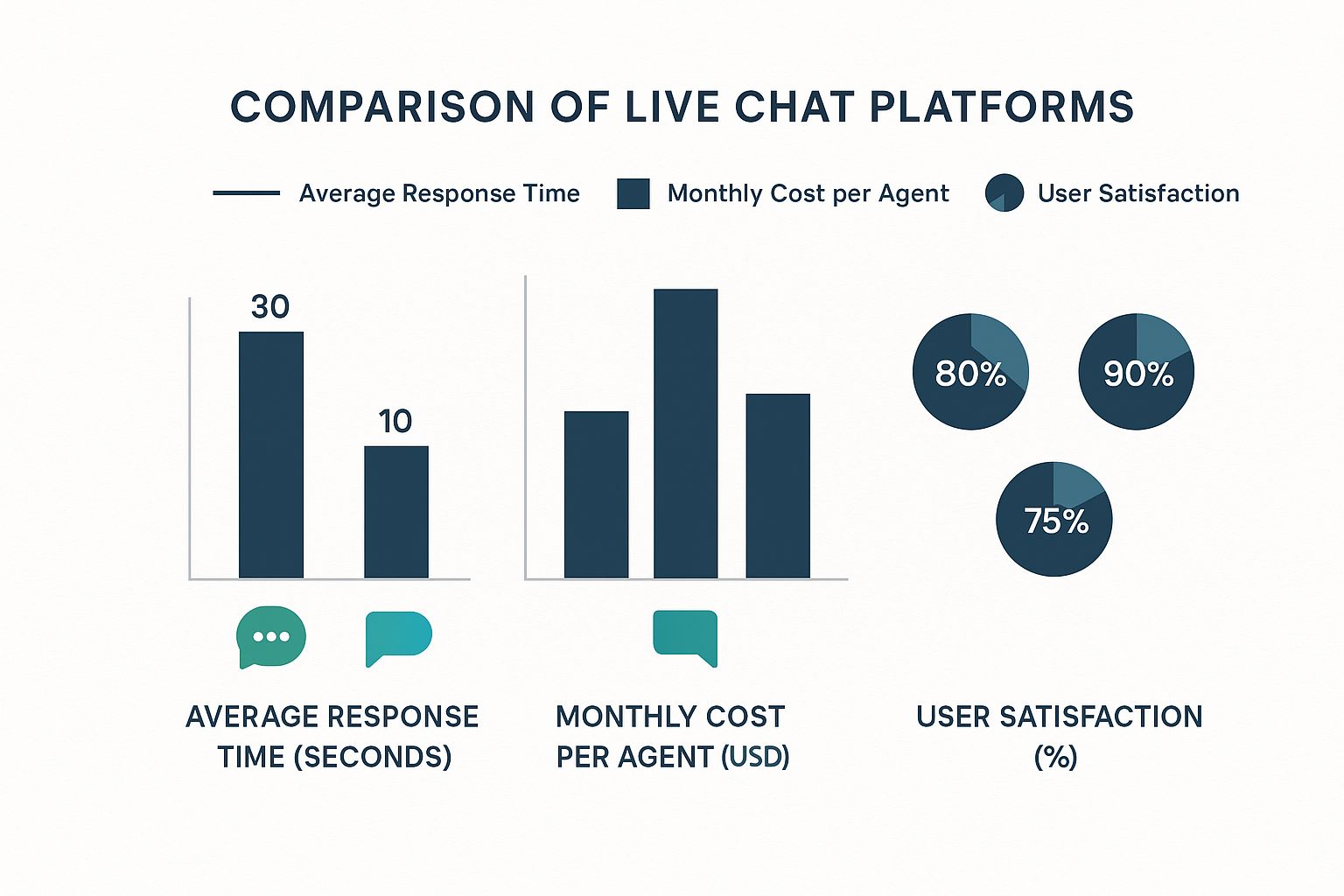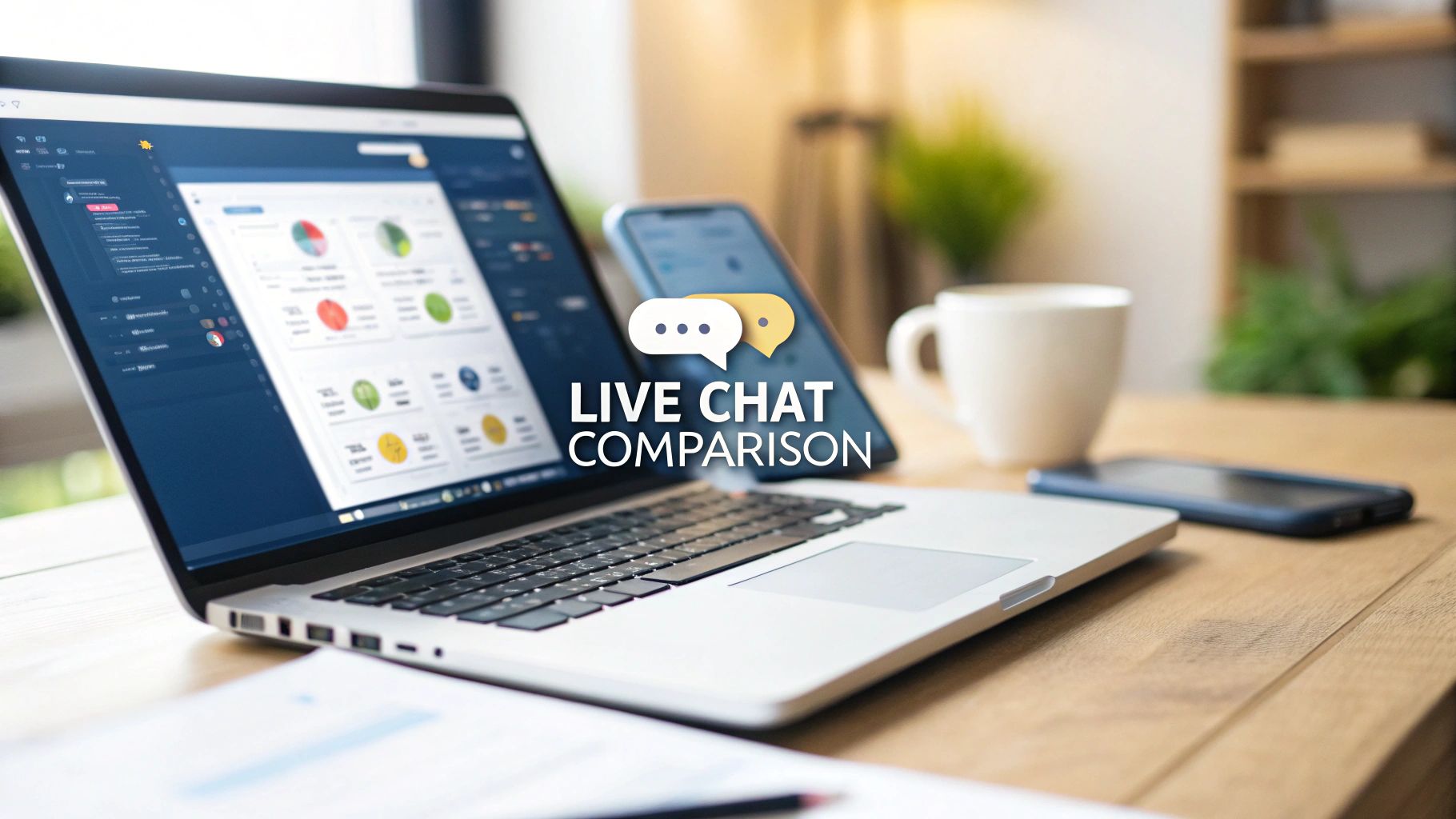Live Chat Software Comparison: A 2024 Guide to Picking the Right Tool
Choosing the best live chat software boils down to a fundamental question: are you trying to generate more sales leads, or are you focused on delivering world-class customer support? Some tools are engineered for proactive, sales-driven conversations, while others are designed to provide efficient, scalable help. The right choice for your business directly impacts revenue and retention, making this a critical strategic decision. This guide provides a detailed live chat software comparison to help you find the perfect fit.
Choosing Your Ideal Live Chat Platform
Picking the right live chat software goes way beyond just ticking off features on a list—it's a cornerstone of your entire customer engagement plan. The market is absolutely booming, with projections showing it could nearly double from $1.1 billion to about $2.17 billion by 2033. This isn't surprising when you consider that roughly 63% of consumers are already using live chat to connect with businesses.
With so many companies jumping on board, you need a clear framework for making a choice. You're not just looking for a tool that works today; you need a partner that can grow with you tomorrow.
Key Decision Factors for Modern Businesses
To make a smart decision, you have to think past the feature list and focus on what you're trying to achieve as a business. The best platform will align perfectly with your main goals, whether that’s converting more trial users, making your support team more efficient, or helping customers get more value out of your product.
Here are the critical factors to consider in your live chat software comparison:
- Scalability and Performance: Can the platform keep up as your company grows? Look closely at how it handles a rising number of chats without slowing down or overwhelming your agents.
- Integration Capabilities: Your live chat tool can't live on an island. It absolutely must connect deeply with your CRM, marketing automation platform, and other core systems to give you a single, unified view of your customer.
- AI and Human Balance: The sweet spot is a platform that blends AI automation for speed and efficiency with genuine human interaction for building real relationships. Getting this right is central to many modern customer communication strategies.
- Overall Engagement Goals: Step back from the tech and think about your big-picture objectives. Reviewing different strategies for interacting with your website visitors can give you a better sense of what's possible and what you truly want to accomplish.
A well-chosen live chat platform does more than just answer questions. It turns customer engagement from a reactive cost center into a proactive engine for growth, making every single conversation an opportunity.
To kick things off, let's start with a high-level look at some of the top players. This quick snapshot will help you get your bearings as we dive deeper into this live chat software comparison.
Quick Live Chat Software Comparison Snapshot
This table gives you a high-level overview of leading live chat platforms, comparing their primary focus, ideal business size, and a standout feature. It's a great way to quickly see which options might be the best fit for your specific needs.
Think of this table as your starting point. It helps narrow down the field so you can focus your attention on the platforms that are most likely to deliver what you're looking for.
Evaluating Core Live Chat Features And Capabilities

If you're going to compare live chat software effectively, you need to know what separates a simple chat widget from a true business asset. A modern live chat tool is much more than a text box; it’s a whole ecosystem of features built to achieve specific goals, whether that's engaging a hesitant visitor or delivering instant, expert help.
These are the advanced capabilities that actually move the needle and deliver real results. They should form the basis of your evaluation checklist, helping you distinguish the must-haves from the nice-to-haves for your company’s specific needs.
Proactive Engagement And Intelligent Routing
The best live chat strategies don't just sit around and wait for a customer to reach out. Proactive chat triggers are a game-changer, letting you automatically start a conversation based on what a user is doing on your site. For instance, you could ping a visitor who has spent more than 30 seconds on your pricing page or someone who has added items to their cart but seems stuck.
Once that chat is live, intelligent routing is what gets it to the right person, fast. Instead of dumping everyone into one massive queue, conversations can be automatically sent to the right department—sales, tech support, billing—based on the page they’re on or answers from a pre-chat survey. This simple step cuts out frustrating internal transfers and slashes customer wait times.
A key differentiator you'll find in top-tier platforms is the ability to route a chat not just to a team, but to the specific agent who has helped that customer before. That kind of continuity builds real rapport and makes for a much better, more personal experience.
Advanced Collaboration And Support Tools
Some customer problems are too tricky for a simple text chat. This is where more advanced, hands-on support features really prove their worth, helping your team resolve complex issues in a fraction of the time.
- Co-browsing: This feature lets an agent securely view and interact with a user's screen in real-time. It’s perfect for walking someone through a confusing setup process or troubleshooting an issue inside your app without all the back-and-forth guesswork.
- Screen Sharing: It’s similar to co-browsing, but the agent can only view the user's screen without clicking around. It’s still incredibly useful for getting immediate context on what a user is seeing.
- Internal Notes and @mentions: Agents can leave private notes on a conversation that only their teammates can see. They can also "@mention" a colleague to quickly ask for help without ever leaving the chat window, making teamwork seamless.
These tools turn a basic chat into a collaborative problem-solving session, which has a direct and positive impact on your first-contact resolution rates and overall customer satisfaction.
Analytics And Automation Capabilities
If you can't measure it, you can't improve it. Solid analytics are non-negotiable for understanding how your team is performing, how happy your customers are, and what impact live chat is actually having. Look for platforms that give you detailed reports on key metrics like first response time, average resolution time, and customer satisfaction (CSAT) scores.
Beyond the basic metrics, it's worth seeing how other businesses are harnessing automation with bots to level up their efforts. Many modern tools now include chatbots that can answer common questions, qualify leads around the clock, and gather preliminary info before passing the chat to a human. This automation frees up your team to focus their energy on the more complex, high-value conversations that really need a human touch.
The Impact of AI on Modern Customer Conversations

Artificial intelligence isn't just a flashy add-on for live chat anymore—it's become a fundamental part of the engine, completely changing how businesses talk to their customers. We've moved past the era of clumsy, rigid chatbots. Today's AI is a dynamic partner that can actually grasp complex user problems and deliver real solutions.
This shift is a massive deal when you're comparing live chat software. It’s no longer enough to just have a chatbot. The real question is how well that AI can qualify a lead, solve a support ticket without human help, or keep the lights on 24/7. This isn't just about cutting costs; it's about building smarter, more personal customer journeys that can scale.
The numbers back this up. The live chat software market is on track to hit US$2,454.4 million by 2031, growing at a steady 8.4% CAGR. It’s the constant innovation in AI and machine learning that’s fueling this growth, with all the top platforms pouring resources into their AI features to keep their edge.
How AI Actually Understands What Customers Want
The magic behind AI-powered chat is Natural Language Processing (NLP). This is what lets the software understand the intent behind a customer’s message, not just the specific words they use. For instance, a customer doesn't need to type "billing question." NLP can figure out that a message like, "My last invoice looks wrong, can you help me check it?" means the exact same thing.
This knack for interpreting conversational language makes the whole experience feel less robotic and more human. It empowers the AI to do some pretty sophisticated things:
- Pinpoint User Intent: The AI can instantly tell if someone is a hot sales lead, needs technical support, or is just browsing for information.
- Pull Out Key Details: It can spot and extract crucial data from the conversation, like an order number or account ID, which seriously speeds up getting to a resolution.
- Gauge Sentiment: Modern AI can even sense if a user is frustrated, happy, or just confused, and then adapt its responses or know when it’s time to escalate to a human agent.
The real beauty of this is that by understanding intent and sentiment, the AI ensures that if a conversation does get handed off to a human, the agent arrives with all the context they need. No more making customers repeat themselves over and over again.
To see this in action, it's worth looking into how real-time AI agent assistance is changing the game by giving human agents live guidance and information while they're in the middle of a chat.
Getting Smarter with Every Conversation
The best AI systems aren’t static; they use machine learning to constantly get better. Every single interaction—whether it’s fully handled by the AI or passed to a person—is a lesson learned.
This continuous feedback loop is what separates a truly advanced conversational AI from a basic bot. The system analyzes what works, figuring out which answers lead to happy customers and which ones don't. It means the chatbot you set up on day one is going to be far more effective and intelligent by day 365. This self-improvement is a core piece of what the future of AI in customer service and the concept of a network of AI agents is all about.
In-Depth Live Chat Software Comparison
Picking the right live chat tool isn't just about ticking feature boxes. It comes down to a clear, side-by-side analysis of what really matters for a growing business: how well it integrates with your existing tech, if it can handle your conversation volume as you scale, its pricing transparency, and the power of its more advanced features.
This isn't a simple checklist. It's a real-world breakdown of the top contenders. My goal is to show you which platform shines in specific situations, whether you're building an enterprise-grade support system or running an aggressive, sales-focused conversational marketing strategy.
Comparing The Titans: Intercom And Drift
On the surface, Intercom and Drift look like direct competitors, but they were built with very different philosophies. Both are absolute powerhouses for proactive engagement, but they are designed for fundamentally different jobs.
Intercom pitches itself as an all-in-one customer communications platform. It’s built to manage the entire customer journey—from acquisition and onboarding to support and re-engagement. Its greatest strength is the unified inbox that pulls every conversation from your website, app, and email into one place. This creates a single source of truth for every customer interaction.
Drift, in contrast, is obsessively focused on B2B sales and marketing acceleration. They practically invented "conversational marketing" to kill the static lead form and replace it with real-time sales conversations. Its entire feature set is engineered to spot high-intent visitors, qualify them with AI, and immediately connect them to a sales rep to book a meeting.
Key Differentiator: While both use chatbots, Intercom's bots are multipurpose, often used for support tasks like surfacing help articles or for marketing announcements. Drift's AI is almost entirely a sales tool, acting as a tireless sales development rep that lives on your website.
Zendesk: The Omnichannel Support Champion
Zendesk comes at the live chat software comparison from a completely different angle. It started with a world-class ticketing system and help desk, so its live chat is just one piece of a much larger omnichannel support suite. For any business where customer service is the sun in their solar system, this deep integration is a game-changer.
When a chat comes through Zendesk, it’s not an isolated event. It’s automatically tied to a complete customer history that includes past tickets, emails, and even phone calls. This gives agents the full context they need to resolve issues faster and more accurately.
This is where you see the real trade-offs between tools built for sales versus those built for support.

The data here shows it clearly—a sales-focused tool might have a higher cost per seat, while a support-focused one prioritizes lightning-fast response times.
Zendesk's AI, called "Answer Bot," is designed to deflect common questions by suggesting relevant knowledge base articles right inside the chat widget. This frees up your human agents to handle the complex, high-stakes issues that demand a personal touch. For companies drowning in support requests, Zendesk's integrated approach is almost always the most logical choice.
LiveChat: The Accessible And User-Friendly Contender
LiveChat has carved out its own space in the market by zeroing in on ease of use, straightforward pricing, and a solid set of core features that just work. It's a fantastic option for small to mid-sized businesses that need a powerful, no-fuss solution for both sales and support without the enterprise-level price tag or complexity.
Its interface is widely considered one of the most intuitive out there, which means teams can get up and running with very little training. The platform also offers strong reporting tools, giving managers a clear view of agent performance, chat volume, and customer satisfaction scores. It’s a true workhorse.
LiveChat gives you a well-rounded feature set that includes:
- Canned Responses: For answering common questions in a single click.
- Chat Tagging: To organize conversations and spot recurring issues or trends.
- Detailed Analytics: To monitor team performance and keep customers happy.
- Ticketing System: For handling complex issues that can't be solved in one chat.
This practical blend of functionality and simplicity makes it a tough all-around competitor in any live chat software comparison.
A Deeper Dive Into Integration And Pricing
A platform's true power is often hidden in its integrations. Intercom, for example, connects with over 300+ other tools, including heavy hitters like Salesforce, Marketo, and Stripe. This lets you trigger highly personalized messages based on what users are doing in your other apps, creating a seamless customer experience.
Zendesk also has a massive app marketplace, but its focus is on tools that streamline the support workflow. Its native connections to other Zendesk products (like Guide and Talk) create a deeply interconnected ecosystem. Some teams even connect it with their internal tools; you can learn more about using Slack for customer support to see how those integrations can slash response times.
To give you a clearer picture, I've put together a table that breaks down these key differences.
Detailed Feature And Integration Comparison
This table summarizes the core strengths of each platform, helping you align their capabilities with your business goals.
Pricing models are the final, critical piece of the puzzle. Intercom's model is based on the number of "people reached," which can get expensive as your user base scales. Drift is also a premium tool, priced to reflect its direct impact on generating high-value B2B leads.
Zendesk and LiveChat stick to a more predictable per-agent, per-month model. This makes budgeting much easier, especially for support teams where staffing is more consistent than marketing reach.
Ultimately, the right choice boils down to your primary goal. Are you trying to shorten your sales cycle, or are you building a world-class support operation? Answering that question is the first step toward picking the perfect live chat platform for your business.
Matching Live Chat Tools To Your Business Goals

After comparing all the features, you quickly realize there's no single "best" live chat platform. The right choice is always the one that plugs directly into your business goals. So, let's stop looking at feature lists for a moment and start thinking about strategic outcomes.
The live chat market is absolutely booming—projected to hit $2,169.8 million by 2033, a huge leap from $1,147.7 million. Why? Because businesses are figuring out that real-time conversations are the key to keeping customers happy and loyal. You can dive deeper into the growth drivers in the live chat market from IMARC Group.
This guide will help you connect the dots between your goals and the right tool, so you can feel confident in your decision.
Best For High-Touch Sales And Lead Qualification
If your main goal is turning website visitors into qualified leads and booked meetings, you need a tool that's built for proactive selling. It's not just about answering questions; it's about actively identifying your best prospects and fast-tracking them through the sales funnel.
Primary Recommendation: Drift
Drift was practically built from the ground up for B2B sales teams. Think of its conversational AI as a 24/7 sales rep that engages visitors, qualifies them based on your ideal customer profile, and books meetings right on your team's calendar. Its seamless integration with Salesforce cements its status as the go-to for companies focused on pure pipeline generation.Strong Alternative: Intercom
While Intercom is more of an all-in-one customer platform, its sales and marketing features are incredibly potent. Its bots can engage visitors based on their on-site behavior, ask qualifying questions, and intelligently route them to the right salesperson. This makes it a serious contender if you want one tool for both sales and support.
Situational Insight: Go with Drift if your north star metric is "sales meetings booked," period. Choose Intercom if you need a strong sales engine but also want that same tool to manage the entire customer journey, from onboarding to support.
Best For Efficient And Scalable Customer Support
When your primary objective shifts to delivering fast, effective, and scalable customer service, the feature set you care about changes completely. The game here is all about resolution times, agent efficiency, and having a single view of the customer across all channels.
Primary Recommendation: Zendesk
When it comes to high-volume, omnichannel support, Zendesk is the undisputed heavyweight. Because its chat is natively built into a world-class help desk, your agents get a complete, unified history of every customer interaction. Its AI-powered Answer Bot is also fantastic for deflecting common questions with knowledge base articles, freeing up your team for more complex issues.Strong Alternative: LiveChat
LiveChat offers a powerful yet incredibly user-friendly solution that shines in a support role, particularly for small to mid-sized businesses. It comes with a built-in ticketing system to manage follow-ups and provides great analytics on agent performance and customer satisfaction. Its simplicity means support teams can get up and running in no time.
Best All-In-One Platform For Startups
Startups and growing SaaS companies often need a single, affordable tool that does a little bit of everything—capturing early leads, onboarding new users, and providing ongoing support. You need a platform that’s powerful but flexible enough to grow with you.
Primary Recommendation: Intercom
This is exactly what Intercom's "Starter" plan was made for. It gives you a potent mix of proactive messaging for sales, a shared inbox for support, and product tours for user onboarding, all in one place. This unified approach keeps your data clean and gives you a holistic view of the customer journey from day one.Strong Alternative: LiveChat
With its predictable per-agent pricing and a solid, well-rounded feature set, LiveChat is a fantastic, budget-conscious choice for startups. It can competently handle both sales and support chats and integrates well with other tools you're already using. It provides a great foundation for customer communication that won't break the bank.
Answering Your Live Chat Software Questions
As you get closer to picking a live chat tool, a few common questions always seem to pop up. Moving from a broad comparison to the final decision means getting clear on things like cost, integrations, and ROI.
This section provides direct answers to those lingering questions. Think of it as your final check to ensure you're investing in a tool that fits your budget and your team's workflow, setting you up for a successful launch.
How Much Does Live Chat Software Typically Cost?
The price tag on live chat software is all over the map, which can make comparing options feel like comparing apples and oranges. You'll find everything from completely free plans with just the basics to enterprise solutions that run thousands of dollars a month.
Most platforms fall into one of two pricing buckets:
- Per-Agent-Seat Model: This is the most common approach. You pay a set monthly fee for every team member who needs to log in and chat. For instance, a plan might be $49/agent/month. It's predictable, which is great for budgeting, especially if your team size is stable.
- Usage or Contacts Model: Other tools, especially those built for marketing, tie their price to your activity. They might charge you based on the number of unique contacts you engage with each month. This can be a great deal when you're small but watch out—the cost can climb quickly as you grow.
My advice? Always look past the headline price. The real cost is often hiding in the fine print. Dig into what triggers extra fees—things like premium features, specific integrations, or what happens when you go over your monthly contact limit. Those surprises are never fun.
How Do I Measure The ROI Of Live Chat?
Proving that your live chat investment is paying off is essential. The best tools come with analytics dashboards, but those numbers are useless if you don't know what you’re looking for.
You need to track key performance indicators (KPIs) that connect directly to your bigger business objectives.
If your sales team is using chat, they should be watching things like lead conversion rates from chat sessions, how much faster deals close when chat is involved, and the number of demos booked right from the widget.
For support teams, it's all about efficiency and happiness. You’ll want to keep a close eye on customer satisfaction (CSAT) scores, first response times, and whether chat is deflecting tickets and lowering your overall support costs. When you stack those improvements against the subscription fee, you’ll have a clear ROI you can stand behind.
Can Live Chat Integrate With My Existing CRM?
Yes, and honestly, if it can't, you should probably walk away. Solid integration is a non-negotiable feature for any modern live chat platform. Pretty much every reputable tool offers native, one-click connections to popular CRMs like Salesforce, HubSpot, and Zoho.
Without that link, your chat tool becomes an island of data, creating manual work and headaches for your team.
A good CRM integration means every chat transcript, lead detail, and customer note gets automatically logged in the right place. This gives your entire company a single, 360-degree view of every customer interaction. It’s what gives your team the context they need to stop asking repetitive questions and start having helpful, personal conversations.
Which Live Chat Software Is Best For Sales Teams?
While a lot of tools can be bent to fit a sales process, some are purpose-built to drive revenue. If your main goal is to generate and qualify leads, you need a proactive platform, not just a reactive one that waits for a visitor to ask a question.
Tools like Drift and Intercom really shine here. They were designed from the ground up to actively engage your best website visitors, use smart chatbots to qualify them 24/7, and even book meetings for your sales reps without a human ever getting involved. Their entire feature set is geared toward turning anonymous website traffic into real sales opportunities, making them a powerful engine for any growth-focused team.
We've covered a lot of ground in this live chat software comparison, but a few questions always remain. Here are concise answers to the most common queries.
Frequently Asked Questions About Live Chat Software
Hopefully, these answers give you the last bit of clarity needed to make a confident choice. The right tool won't just solve a problem; it will become a core part of how you communicate with customers and grow your business.
Ready to transform your visitor engagement, convert more trials, and increase customer lifetime value? Worknet.ai Inc combines AI-powered conversations with seamless expert handoffs to deliver results across the entire customer journey. Learn more about Worknet.ai.
FAQs
.png)
Lorem ipsum dolor sit amet, consectetur adipiscing elit. Suspendisse varius enim in eros elementum tristique. Duis cursus, mi quis viverra ornare, eros dolor interdum nulla, ut commodo diam libero vitae erat. Aenean faucibus nibh et justo cursus id rutrum lorem imperdiet. Nunc ut sem vitae risus tristique posuere.
Lorem ipsum dolor sit amet, consectetur adipiscing elit. Suspendisse varius enim in eros elementum tristique. Duis cursus, mi quis viverra ornare, eros dolor interdum nulla, ut commodo diam libero vitae erat. Aenean faucibus nibh et justo cursus id rutrum lorem imperdiet. Nunc ut sem vitae risus tristique posuere.
Lorem ipsum dolor sit amet, consectetur adipiscing elit. Suspendisse varius enim in eros elementum tristique. Duis cursus, mi quis viverra ornare, eros dolor interdum nulla, ut commodo diam libero vitae erat. Aenean faucibus nibh et justo cursus id rutrum lorem imperdiet. Nunc ut sem vitae risus tristique posuere.
Lorem ipsum dolor sit amet, consectetur adipiscing elit. Suspendisse varius enim in eros elementum tristique. Duis cursus, mi quis viverra ornare, eros dolor interdum nulla, ut commodo diam libero vitae erat. Aenean faucibus nibh et justo cursus id rutrum lorem imperdiet. Nunc ut sem vitae risus tristique posuere.
Lorem ipsum dolor sit amet, consectetur adipiscing elit. Suspendisse varius enim in eros elementum tristique. Duis cursus, mi quis viverra ornare, eros dolor interdum nulla, ut commodo diam libero vitae erat. Aenean faucibus nibh et justo cursus id rutrum lorem imperdiet. Nunc ut sem vitae risus tristique posuere.
Lorem ipsum dolor sit amet, consectetur adipiscing elit. Suspendisse varius enim in eros elementum tristique. Duis cursus, mi quis viverra ornare, eros dolor interdum nulla, ut commodo diam libero vitae erat. Aenean faucibus nibh et justo cursus id rutrum lorem imperdiet. Nunc ut sem vitae risus tristique posuere.
Lorem ipsum dolor sit amet, consectetur adipiscing elit. Suspendisse varius enim in eros elementum tristique. Duis cursus, mi quis viverra ornare, eros dolor interdum nulla, ut commodo diam libero vitae erat. Aenean faucibus nibh et justo cursus id rutrum lorem imperdiet. Nunc ut sem vitae risus tristique posuere.
Lorem ipsum dolor sit amet, consectetur adipiscing elit. Suspendisse varius enim in eros elementum tristique. Duis cursus, mi quis viverra ornare, eros dolor interdum nulla, ut commodo diam libero vitae erat. Aenean faucibus nibh et justo cursus id rutrum lorem imperdiet. Nunc ut sem vitae risus tristique posuere.
Lorem ipsum dolor sit amet, consectetur adipiscing elit. Suspendisse varius enim in eros elementum tristique. Duis cursus, mi quis viverra ornare, eros dolor interdum nulla, ut commodo diam libero vitae erat. Aenean faucibus nibh et justo cursus id rutrum lorem imperdiet. Nunc ut sem vitae risus tristique posuere.
Lorem ipsum dolor sit amet, consectetur adipiscing elit. Suspendisse varius enim in eros elementum tristique. Duis cursus, mi quis viverra ornare, eros dolor interdum nulla, ut commodo diam libero vitae erat. Aenean faucibus nibh et justo cursus id rutrum lorem imperdiet. Nunc ut sem vitae risus tristique posuere.

.svg)


.webp)
.webp)
.webp)




